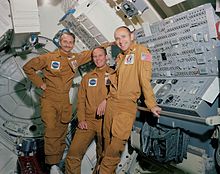Skylab 3

Skylab as seen by the arriving Skylab 3 crew
|
|||||
| Operator | NASA | ||||
|---|---|---|---|---|---|
| COSPAR ID | 1973-050A | ||||
| SATCAT № | 6757 | ||||
| Mission duration | 59 days, 11 hours, 09 minutes, 01 seconds | ||||
| Distance travelled | 39,400,000 kilometers (24,500,000 mi) | ||||
| Orbits completed | 858 | ||||
| Spacecraft properties | |||||
| Spacecraft | Apollo CSM-117 | ||||
| Manufacturer | North American Rockwell | ||||
| Launch mass | 20,121 kilograms (44,359 lb) | ||||
| Crew | |||||
| Crew size | 3 | ||||
| Members | |||||
| Start of mission | |||||
| Launch date | July 28, 1973, 11:10:50 UTC | ||||
| Rocket | Saturn IB SA-207 | ||||
| Launch site | Kennedy LC-39B | ||||
| End of mission | |||||
| Recovered by | USS New Orleans | ||||
| Landing date | September 25, 1973, 22:19:51 UTC | ||||
| Landing site | 30°47′N 120°29′W / 30.783°N 120.483°W | ||||
| Orbital parameters | |||||
| Reference system | Geocentric | ||||
| Regime | Low Earth | ||||
| Perigee | 423 kilometers (263 mi) | ||||
| Apogee | 441 kilometers (274 mi) | ||||
| Inclination | 50.0 degrees | ||||
| Period | 93.2 minutes | ||||
| Epoch | August 8, 1973 | ||||
| Docking with Skylab | |||||
| Docking port | Forward | ||||
| Docking date | July 28, 1973, 19:37:00 UTC | ||||
| Undocking date | September 25, 1973, 11:16:42 UTC | ||||
| Time docked | 58 days, 15 hours, 39 minutes, 42 seconds | ||||
|
|
|||||

Due to a NASA management error, manned Skylab mission patches were designed in conflict with the official mission numbering scheme.
L-R: Garriott, Lousma and Bean
Skylab 3 (also SL-3 and SLM-2) was the second manned mission to the first American space station, Skylab. The mission began July 28, 1973, with the launch of three astronauts on the Saturn IB rocket, and lasted 59 days, 11 hours and 9 minutes. A total of 1,084.7 astronaut-utilization hours were tallied by the Skylab 3 crew performing scientific experiments in the areas of medical activities, solar observations, Earth resources, and other experiments.
The manned Skylab missions were officially designated Skylab 2, 3, and 4. Mis-communication about the numbering resulted in the mission emblems reading Skylab I, Skylab II, and Skylab 3 respectively.
During the approach phase, a propellant leak developed in one of the Apollo Service Module's reaction control system thruster quads. The crew was able to safely dock with Skylab, but troubleshooting continued with the problem. Six days later, another thruster quad developed a leak, creating concern amongst Mission Control. For the first time, an Apollo spacecraft would be rolled out to Launch Complex 39 for a rescue mission, made possible by the ability for the station to have two Apollo CSMs docked at the same time. It was eventually determined that the CSM could be safely maneuvered using only two working thruster quads, and the rescue mission was never launched.
The crew, during their first EVA, installed the twin-pole sunshade, one of the two solutions for the destruction of the micrometeoroid shield during Skylab's launch to keep the space station cool. It was installed over the parasol, which was originally deployed through a porthole airlock during Skylab 2. Both were brought to the station by Skylab 2.
...
Wikipedia
